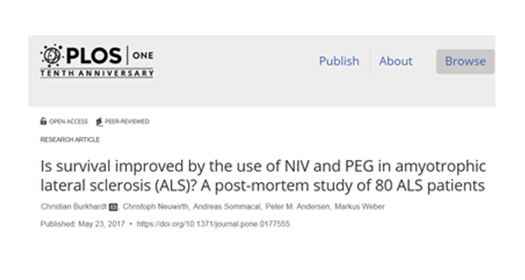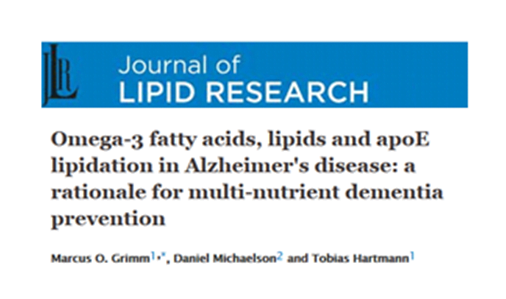 “Is survival improved by the use of NIV and PEG in amyotrophic lateral sclerosis? A post-mortem study of 80 ALS patients” has been published in the journal PLOS ONE. This work was supported in part by JPND through the SOPHIA project, selected in the 2011 Biomarkers call and the STRENGTH project, selected in the 2012 Risk Factors call.
“Is survival improved by the use of NIV and PEG in amyotrophic lateral sclerosis? A post-mortem study of 80 ALS patients” has been published in the journal PLOS ONE. This work was supported in part by JPND through the SOPHIA project, selected in the 2011 Biomarkers call and the STRENGTH project, selected in the 2012 Risk Factors call.
Yearly Archives: 2017
A new study of the neural circuits that underlie long-term memory formation reveals, for the first time, that memories are formed simultaneously in the hippocampus and the long-term storage location in the brain’s cortex. However, the long-term memories remain “silent” for about two weeks before reaching a mature state.
The findings, which were published in Science, may force some revision of the dominant models of how memory consolidation occurs, the researchers say.
Neuroscientists have developed two major models to describe how memories are transferred from short- to long-term memory. The earliest, known as the standard model, proposes that short-term memories are initially formed and stored in the hippocampus only, before being gradually transferred to long-term storage in the neocortex and disappearing from the hippocampus.
A more recent model, the multiple trace model, suggests that traces of episodic memories remain in the hippocampus. These traces may store details of the memory, while the more general outlines are stored in the neocortex.
In 2012, the researchers developed a way to label cells called engram cells, which contain specific memories, allowing them to trace the circuits involved in memory storage and retrieval. They can also artificially reactivate memories by using optogenetics, a technique that allows them to turn target cells on or off using light.
In the current study, the researchers used this approach to label memory cells in mice during a fear-conditioning event — that is, a mild electric shock delivered when the mouse is in a particular chamber. Then, they could use light to artificially reactivate these memory cells at different times and see if that reactivation provoked a behavioral response from the mice (freezing in place). The researchers could also determine which memory cells were active when the mice were placed in the chamber where the fear conditioning occurred, prompting them to naturally recall the memory.
The researchers labeled memory cells in three parts of the brain: the hippocampus, the prefrontal cortex, and the basolateral amygdala, which stores memories’ emotional associations.
Just one day after the fear-conditioning event, the researchers found that memories of the event were being stored in engram cells in both the hippocampus and the prefrontal cortex. However, the engram cells in the prefrontal cortex were “silent” — they could stimulate freezing behavior when artificially activated by light, but they did not fire during natural memory recall.
Over the next two weeks, the silent memory cells in the prefrontal cortex gradually matured, as reflected by changes in their anatomy and physiological activity, until the cells became necessary for the animals to naturally recall the event. By the end of the same period, the hippocampal engram cells became silent and were no longer needed for natural recall. However, traces of the memory remained: Reactivating those cells with light still prompted the animals to freeze.
In the basolateral amygdala, once memories were formed, the engram cells remained unchanged throughout the course of the experiment. Those cells, which are necessary to evoke the emotions linked with particular memories, communicate with engram cells in both the hippocampus and the prefrontal cortex.
The findings suggest that traditional theories of consolidation may not be accurate, because memories are formed rapidly and simultaneously in the prefrontal cortex and the hippocampus.
Further studies are needed to determine whether memories fade completely from hippocampal cells or if some traces remain. Right now, the researchers can only monitor engram cells for about two weeks, but they are working on adapting their technology to work for a longer period. The researchers also plan to further investigate how the prefrontal cortex engram maturation process occurs.
Paper: “Engrams and circuits crucial for systems consolidation of a memory”
Reprinted from materials provided by Massachusetts Institute of Technology.
 “Endocytic vesicle rupture is a conserved mechanism of cellular invasion by amyloid proteins” has been published in the journal Acta Neuropathologica. This work was supported in part by JPND through the NeuTARGETs project, selected in the 2013 Cross-Disease Analysis call, and the SYNACTION project, selected in the 2015 JPco-fuND call.
“Endocytic vesicle rupture is a conserved mechanism of cellular invasion by amyloid proteins” has been published in the journal Acta Neuropathologica. This work was supported in part by JPND through the NeuTARGETs project, selected in the 2013 Cross-Disease Analysis call, and the SYNACTION project, selected in the 2015 JPco-fuND call.
A new study published in PLOS Medicine has found that the metabolism of omega-3 and omega-6 unsaturated fatty acids in the brain are associated with the progression of Alzheimer’s disease.
Currently it is thought that the main reason for developing memory problems in Alzheimer’s disease and dementia is the presence of two big molecules in the brain called tau and amyloid proteins. These proteins have been extensively studied and have been shown to start accumulating in the brain up to 20 years prior to the onset of the disease. However, there is limited information on how small molecule metabolism in the brain is associated with the development and progression of Alzheimer’s disease.
In this study, researchers looked at brain tissue samples from 43 people ranging in age from 57 to 95 years old. They compared the differences in hundreds of small molecules in three groups: 14 people with healthy brains, 15 that had high levels of tau and amyloid but didn’t show memory problems and 14 clinically diagnosed Alzheimer’s patients.
They found that unsaturated fatty acids were significantly decreased in Alzheimer’s brains when compared to brains from healthy patients. While acknowledging that the study was small, the scientists said that their study showed surprising results, including that the omega-3 fatty acid DHA, which is commonly taken as a supplement, was found to increase as the disease progressed.
The researchers plan to continue this path of inquiry in larger future studies.
Paper: “Association between fatty acid metabolism in the brain and Alzheimer disease neuropathology and cognitive performance: A nontargeted metabolomic study”
Reprinted from materials provided by King’s College London.
A new study has found a link between neurological birth defects in infants commonly found in pregnant women with diabetes and several neurodegenerative diseases, including Alzheimer’s, Parkinson’s and Huntington’s diseases.
The findings were published in the Proceedings of the National Academy of Sciences.
Neural tube defects occur when misfolded proteins accumulate in the cells of the developing nervous system. The misfolded proteins form insoluble clumps and cause widespread cell death, eventually leading to birth defects. Protein clumps also play a major role in Alzheimer’s, Parkinson’s and Huntington’s disease. In Alzheimer’s, for instance, this leads to the accumulation of plaques in the brain, reducing the ability of that organ to function.
The researchers studied pregnant mice with diabetes, and found that their embryos contained clumps of at least three misfolded proteins that are also associated with the three neurodegenerative diseases: α-Synuclein, Parkin, and Huntingtin.
This latest research also underscores the links between diabetes and some neurodegenerative diseases. People with diabetes have a higher risk of Alzheimer’s and Parkinson’s disease, and some research suggests that there are molecular links between Huntington’s and diabetes as well.
The scientists also examined whether it is possible to reduce levels of the misfolded proteins, and in so doing reduce neural tube defects. They gave diabetic pregnant animals sodium 4-phenylbutyrate (PBA), a compound that can reduce mistakes in molecular structure by aiding the molecules that ensure proper protein folding. In the animals that received PBA, there was significantly less protein misfolding, and fewer neural tube defects in the embryos. PBA has already been approved by the US Food and Drug Administration for other uses, and if it proves safe and effective in humans for this purpose, it could potentially reach patients much more quickly than an entirely new drug.
Paper: “Formation of neurodegenerative aggresome and death-inducing signaling complex in maternal diabetes-induced neural tube defects”
Reprinted from materials provided by the University of Maryland School of Medicine.
 “Neuronal DNA Methyltransferases: Epigenetic Mediators between Synaptic Activity and Gene Expression?” has been published in the journal The Neuroscientist. This work was supported in part by JPND through the STAD project, selected in the 2015 JPco-fuND call.
“Neuronal DNA Methyltransferases: Epigenetic Mediators between Synaptic Activity and Gene Expression?” has been published in the journal The Neuroscientist. This work was supported in part by JPND through the STAD project, selected in the 2015 JPco-fuND call.
 “Omega-3 fatty acids, lipids and apoE lipidation in Alzheimer’s disease: a rationale for multi-nutrient dementia prevention” has been published in the Journal of Lipid Research. This work was supported in part by JPND through the MIND-AD project, selected in the 2013 Preventive Strategies call.
“Omega-3 fatty acids, lipids and apoE lipidation in Alzheimer’s disease: a rationale for multi-nutrient dementia prevention” has been published in the Journal of Lipid Research. This work was supported in part by JPND through the MIND-AD project, selected in the 2013 Preventive Strategies call.
 Prof. Philippe Amouyel, Chair of the JPND Management Board, discusses JPND progress and priorities for the future in issue one of Pan European Networks: Health.
Prof. Philippe Amouyel, Chair of the JPND Management Board, discusses JPND progress and priorities for the future in issue one of Pan European Networks: Health.
In the interview, Prof. Amouyel outlines some of JPND’s major recent and future developments and discusses the ongoing JPND call for research projects for pathway analysis across neurodegenerative diseases.
Click here to read the full article.
A study has shown that suppressing a certain protein in a mouse model of amyotrophic lateral sclerosis (ALS) could markedly extend the animal’s life span. In one experiment, none of the untreated mice lived longer than 29 days, while some of the treated mice lived over 400 days.
This study was published in the journal Nature.
ALS is a disease in which the nerve cells in the brain and spinal cord degenerate, leading to wasting of the muscles. Patients gradually lose the ability to move, speak, eat or breathe, often leading to paralysis and death within two to five years. It is associated with environmental risk factors, such as old age and military service. In addition, mutations in certain genes can cause ALS. Exactly how ALS works is still poorly understood, but knowing which genes are involved can point researchers toward processes inside cells that would be good targets for drugs.
One indicator of ALS, as well as other neurodegenerative diseases, is clumps of protein in the brain. In ALS, these clumps, or aggregates, are made up of a protein called TDP-43. Eliminating TDP-43, and therefore the TDP-43 aggregates, might seem like a good way to prevent or cure ALS. But cells need TDP-43 to survive, so suppressing TDP-43 itself is not a good idea.
A different approach was needed. The researchers knew that a second protein, ataxin 2, helped cells survive when TDP-43 formed toxic clumps. Unlike TDP-43, ataxin 2 is not essential for a cell’s survival, making it a reasonable therapeutic target.
In a previous study, the team had shown that when ataxin 2 is suppressed or blocked in yeast cultures and fruit flies that carry the human TDP-43 gene, cells are more resistant to the potential toxic effects of the clumping TDP-43 protein.
In still another study, the scientists had shown that versions of the human ataxin 2 gene that resulted in a more stable ataxin 2 protein — and therefore more of the protein — increased the risk for developing ALS. The researchers reasoned that if mutations that increased the amount of ataxin 2 raised the risk of ALS, maybe lowering the amount of ataxin 2 would protect a person from ALS.
The scientists used genetically engineered mice whose neurons produced human TDP-43 protein at high levels. These mice exhibit some features that resemble human ALS, including a buildup of clumps of TDP-43 in their neurons. These mice also have difficulty walking and typically have life spans of no more than 30 days. They genetically engineered these ALS mice to have half the normal amount of ataxin 2, and also engineered other mice to completely lack the protein. The researchers found that with half the ataxin 2, the ALS-like mice survived much longer, and with no ataxin 2, the mice lived for hundreds of days.
The team next tried something that could have a more direct therapeutic value: treating mice with a type of DNA-like drug, designed to block the production of ataxin 2. These so called “antisense oligonucleotides” are strands of synthetic DNA that target a gene and block the expression of the protein that it encodes. Delivery of the antisense oligonucleotides to the nervous systems of some of the ALS mice enabled them to maintain their health much longer than the ALS mice treated with a placebo.
The scientists said the study showed that suppressing ataxin 2 delayed onset and slowed the progression of the ALS-like disease in mice that were not yet showing symptoms. Whether oligonucleotides or other protein-blocking treatments could reverse symptoms in mice that are already sick is another question. Because TDP-43 clumping occurs in nearly all ALS cases, targeting ataxin 2 could be a broadly effective therapeutic strategy, they say.
Paper: “Therapeutic reduction of ataxin-2 extends lifespan and reduces pathology in TDP-43 mice”
Reprinted from materials provided by Stanford University Medical Center.
The trio of Presidencies of the Council of the European Union 2016-2017 (the Netherlands, Slovakia and Malta) have signed a Joint Statement on Dementia, issued during the meeting of the governmental expert group on dementia in Malta on May 15-16, 2017.
The statement calls on the European Commission and EU Members States to promote and support international cooperation in dementia research and improve the coordination of existing European research programmes such as JPND.
Click here to download the full statement.
